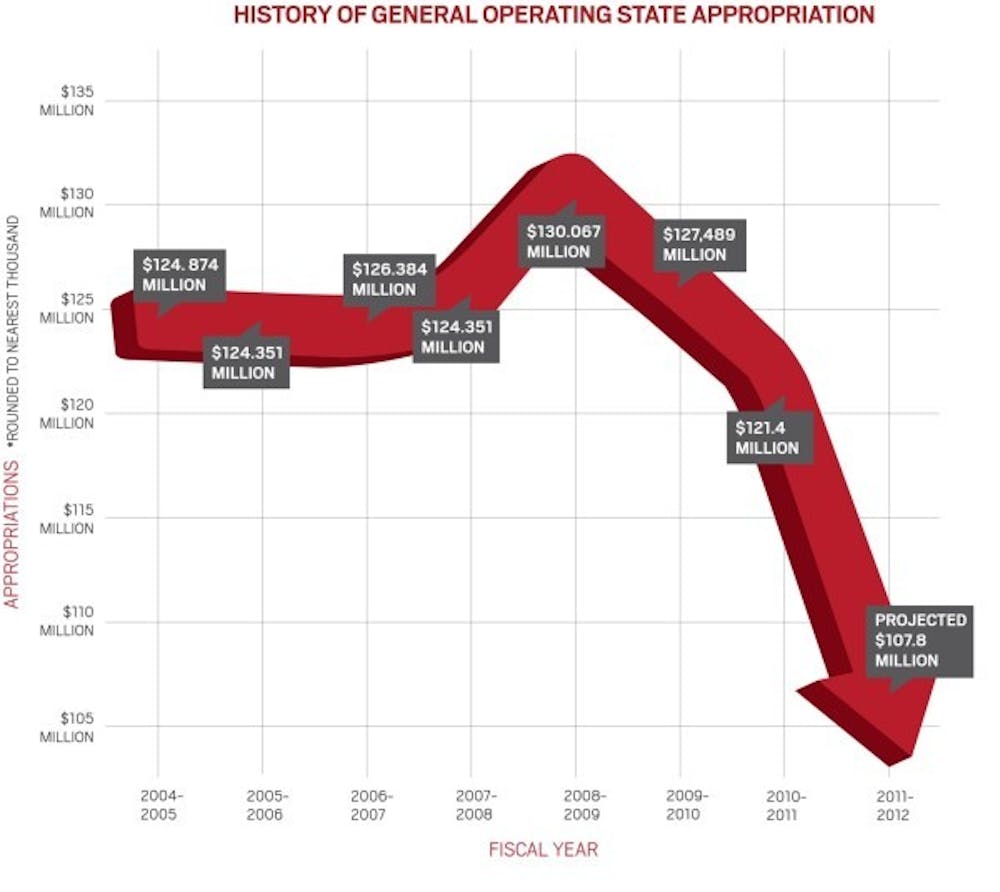President Jo Ann Gora is "going to bat" for Ball State, appearing before the House Ways and Means Committee last week to contest recommended budget cuts for the university.
Ball State faces a possible $23.4 million budget cut for the next two years, representing a chunk of funding that's 54 percent bigger than the cuts issued this time last year.
Ball State isn't against the idea of incentive-based funding, vice president of business affairs and university treasurer Randy Howard said. But when the state doesn't consider improvement over time, it's "puzzling and challenging" to find a solution, he said.
At the meeting in Indianapolis Wednesday, Gora compared ICHE's formula to a game of baseball.
"It's almost as if you were at a baseball game and they decided the winner based not on what happened over the full nine innings, but took a look at what happened between the sixth and seventh innings, and said the winner is determined by the team that got more runs in the seventh inning than they got in the sixth inning," Gora said.
She's referring to ICHE's new formula for incentive-based funding, which takes 5 percent, or $123 million, of the state's higher education funding and reallocates it to public universities based on performance. ICHE recommended Ball State receive just 1.4 percent of those funds based on a formula that considers graduation rates as the most weighted priority. The commission suggests Ball State's budget be cut by $13.6 million on top of that.
The commission considered graduation rates for the incoming freshman classes of fall 2003 and 2005. During that time frame, graduation rates at Ball State fell just 1.1 percent, while three of the five public four-year institutions increased their graduation rates.
"Our priorities are in line with the state's," Howard said. "Increasing graduation rates are a priority of the state. The differences have been how you reward it and the time to degree metric."
If the commission considered trends from 2002 to 2008, Ball State would rank highest among four-year public research institutions in the state and tie for sixth place in the nation, according to a Dec. 5 article from The Chronicle of Higher Education.
Other criteria for the performance funding formula include completion of credit hours and research incentive. Even though Ball State does conduct research, it was never considered for research funding. Last week, the university was promoted from a "doctoral/research university" to a "research university (high research activity)" by the Carnegie Foundation for the Advancement of Teaching, an independent policy and research center that publishes reports about all levels of education.
Howard said he hopes this new classification will lead to research incentive funding from the state, noting that other state universities classified by Carnegie have received state funding for research.
As Howard crunches numbers from his office in the Frank A. Bracken Administration Building, he's aided by some top budget experts — Bernie Hannon and Gretchen Gutman, associate vice presidents of business affairs and governmental affairs. Each has an extensive background in budget analysis, giving Ball State an insider's knowledge of how the process works.
"The General Assembly always puts its own stamp on the higher education budget," said Hannon, the former chief financial officer for ICHE. "The General Assembly has never taken the recommendations of the Commission for Higher Education to the dollar."
Howard said he's not sure where cuts will be made.
"Everything's on the table," he said. "Students and quality of education was our priority last time, and that won't change."
It's too early to talk about a possible increase in tuition, he said, noting that the Board of Trustees makes the final decision on tuition increases. Tuition is considered, and often increased, every two years. This spring the board will consider a tuition increase as it sets the operating budget for the next school year.
"Our operating budget is like a rocket," Howard said, "with state funding going down and tuition going up."
The operating budget for this school year is $121.4 million, according to the board report from May 2010. One-third of the funding for Ball State's total expenditures come from state appropriations.
During the next couple of months, the House and Senate will consider budget recommendations before sending a proposal to the General Assembly, which has to make a final decision by the end of the session on April 30.
In January and February, the Ways and Means Committee will hold budget hearings. At the end of February, the full body of the House of Representatives will consider the bill before sending it to the Senate Appropriations Committee to review. The entire Senate body will vote on the bill, and in April, the conference committee will meet. At that time, the revised state revenue forecast will be published, which is key in making final budget decisions, Howard said.
"If revenue forecasts are going up, that's information the General Assembly might use and say there's more money available," he said. "If the revenue forecast goes down, they would use that information to say the budget might be smaller."
For Ball State administrators, it's a lengthy process leading up to April 30. Howard said it's like a marathon.
"Sometimes I wish we would get to an end point sooner," he said. "It's still a process. We're still running a race. We'll be telling [legislators] the story of Ball State, and we're hoping that story will resonate."



